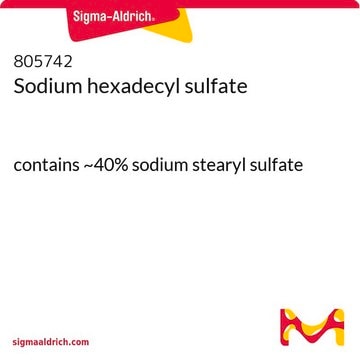293946
Octadecyl sulfate sodium salt
technical grade, 93%
Autenticatiper visualizzare i prezzi riservati alla tua organizzazione & contrattuali
About This Item
Formula condensata:
CH3(CH2)17OSO3Na
Numero CAS:
Peso molecolare:
372.54
Numero CE:
Numero MDL:
Codice UNSPSC:
12352100
ID PubChem:
NACRES:
NA.22
Prodotti consigliati
Grado
technical grade
Saggio
93%
Punto di fusione
211-213 °C (lit.)
Stringa SMILE
[Na+].CCCCCCCCCCCCCCCCCCOS([O-])(=O)=O
InChI
1S/C18H38O4S.Na/c1-2-3-4-5-6-7-8-9-10-11-12-13-14-15-16-17-18-22-23(19,20)21;/h2-18H2,1H3,(H,19,20,21);/q;+1/p-1
NWZBFJYXRGSRGD-UHFFFAOYSA-M
Categorie correlate
Avvertenze
Warning
Indicazioni di pericolo
Consigli di prudenza
Classi di pericolo
Eye Irrit. 2 - Skin Irrit. 2 - STOT SE 3
Organi bersaglio
Respiratory system
Codice della classe di stoccaggio
11 - Combustible Solids
Classe di pericolosità dell'acqua (WGK)
WGK 2
Punto d’infiammabilità (°F)
Not applicable
Punto d’infiammabilità (°C)
Not applicable
Dispositivi di protezione individuale
dust mask type N95 (US), Eyeshields, Gloves
Scegli una delle versioni più recenti:
Possiedi già questo prodotto?
I documenti relativi ai prodotti acquistati recentemente sono disponibili nell’Archivio dei documenti.
I clienti hanno visto anche
Properties of ionized monolayers. Part 5.-Surface potentials and pressures of insoluble monolayers of sodium octadecyl sulphate.
Mingins J and Pethica BA.
Transactions of the Faraday Society, 59, 1892-1905 (1963)
Nan Zhang et al.
European journal of pharmaceutics and biopharmaceutics : official journal of Arbeitsgemeinschaft fur Pharmazeutische Verfahrenstechnik e.V, 116, 66-75 (2016-12-19)
Nanoparticles can improve topical drug delivery: size, surface properties and flexibility of polymer nanoparticles are defining its interaction with the skin. Only few studies have explored skin penetration for one series of structurally related polymer particles with systematic alteration of
Astrid Von Mentzer et al.
Virulence, 11(1), 381-390 (2020-04-05)
The ability to adhere via colonization factors to specific receptors located on the intestinal mucosa is a key virulence factor in enterotoxigenic Escherichia coli (ETEC) pathogenesis. Here, the potential glycosphingolipid receptors of the novel human ETEC colonization factor CS30 were
Concepción Abril et al.
Chemosphere, 268, 128823-128823 (2020-11-09)
The uptake, bioconcentration and translocation of 22 endocrine disrupting compounds (six perflurocarboxylic acids (PFAAs), perfluorooctanoic sulfonic acid, four anionic surfactants (alkylsulfates (ASC) from C12 to C16), bisphenol A (BPA), four preservatives (parabens), two biocides (triclosan (TCS) and triclocarban (TCB)) and
Concepción Abril et al.
The Science of the total environment, 711, 135048-135048 (2019-12-10)
In this work, twenty-three endocrine disrupting compounds have been monitored in sludge from different stages of four sludge stabilization treatments (anaerobic digestion, aerobic digestion, composting and anaerobic stabilization ponds). Their occurrence and fate in sludge stabilization plants and their potential
Il team dei nostri ricercatori vanta grande esperienza in tutte le aree della ricerca quali Life Science, scienza dei materiali, sintesi chimica, cromatografia, discipline analitiche, ecc..
Contatta l'Assistenza Tecnica.







![1,8-diazabiciclo[5.4.0]undec-7-ene 98%](/deepweb/assets/sigmaaldrich/product/structures/120/564/5b373e23-1624-489c-8efb-692de0f96ffb/640/5b373e23-1624-489c-8efb-692de0f96ffb.png)






